Menus
- The super sports mega test part 3: high-speed
- The trilogy at a glance
- Conclusion
- MOTORCYCLE overall rating
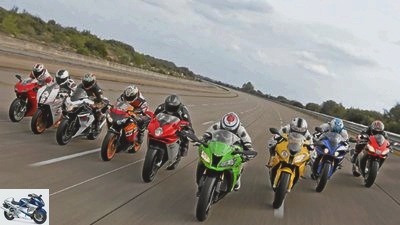
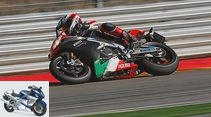
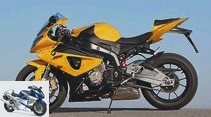
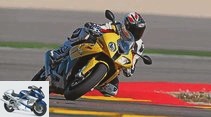
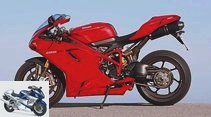
82 photos
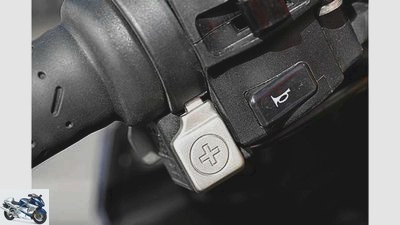
Arts
1/82
Easy to use traction control of the Aprilia.
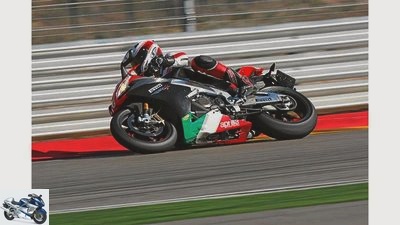
Arts
2/82
A thoroughbred racing file with incredible handling.
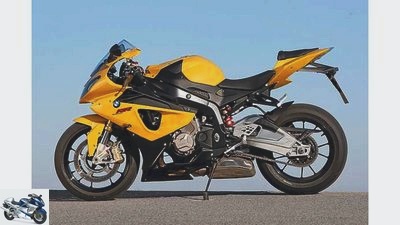
Arts
3/82
BMW S 1000 RR.
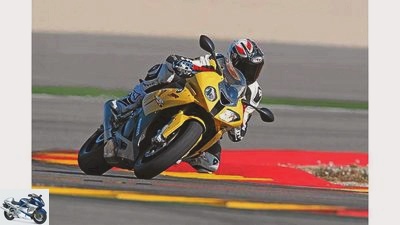
Arts
4/82
The BMW S 1000 RR is equipped with spring elements that master the balancing act between acceptable comfort and sportiness.
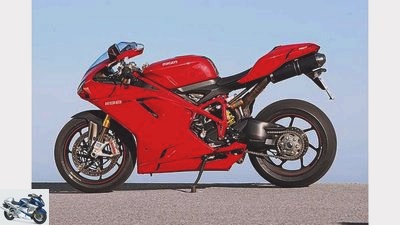
Arts
5/82
Ducati 1198 SP.

Arts
6/82
Thanks to the softer spring, the Ducati has a slightly better balance.

Arts
7/82
Kawasaki ZX-10R.
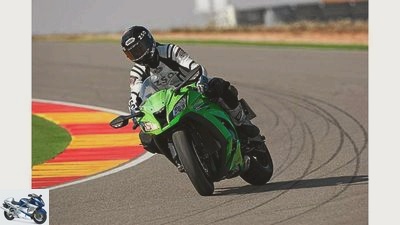
Arts
8/82
The ZX-10R delights with first-class braking stability.
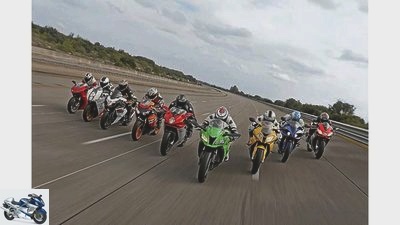
Arts
9/82
In line and speed.
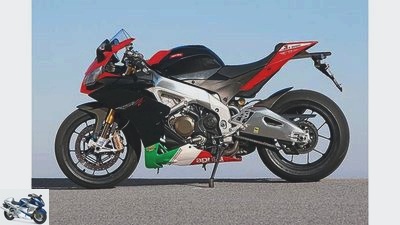
Arts
10/82
Aprilia RSV4.
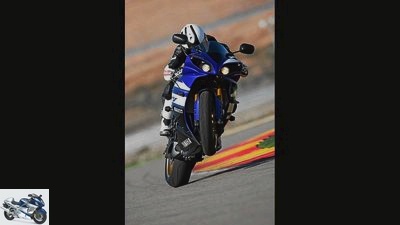
Arts
11/82
The four-cylinder of the Yamaha YZF-R1 was the first to break into the speed range of the 600s.
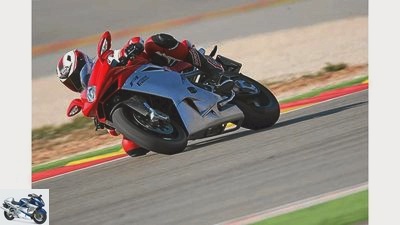
Arts
12/82
The MV Agusta F4 is a feast for the eyes in terms of workmanship.
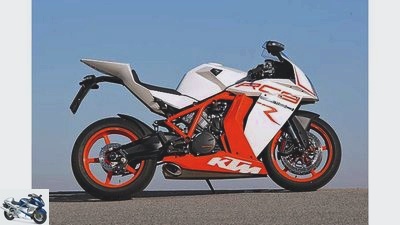
Arts
13/82
KTM 1190 RC8 R..
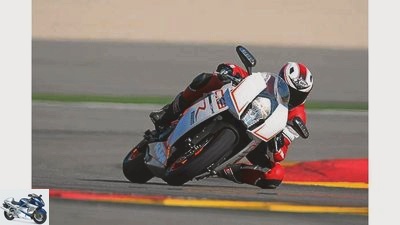
Arts
14/82
The KTM 1190 RC8 R is one of the handiest machines in the field.
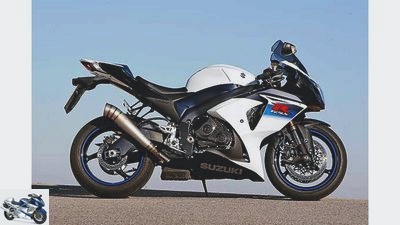
Arts
15/82
Suzuki GSX-R 1000.
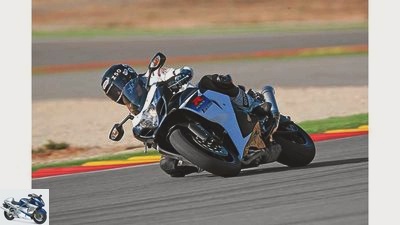
Arts
16/82
Yoshimura exhausts and high windshield only adorn the special model of the Suzuki GSX-R 1000.
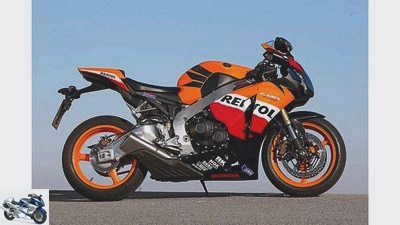
Arts
17/82
Honda Fireblade.
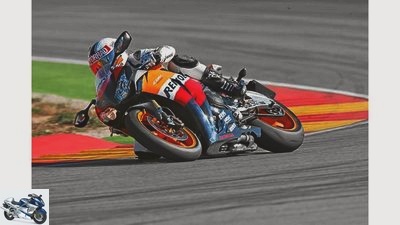
Arts
18/82
Its balance and powerful pulling power are the strengths of the Honda Fireblade.
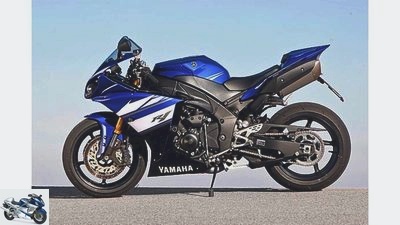
Arts
19/82
Yamaha YZF-R1.
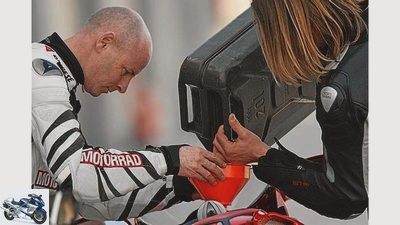
Arts
20/82
Typical: Everyone wants to drive, nobody refuel, that is easily neglected.
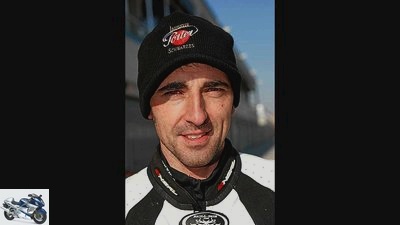
Arts
21/82
Tester: Christian Kellner (MOTORRAD).
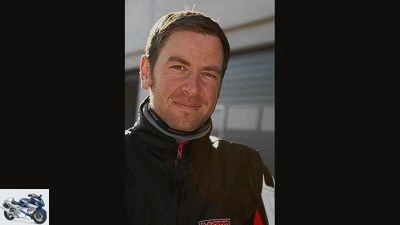
Arts
22/82
Tester: Aurelien Ranea.
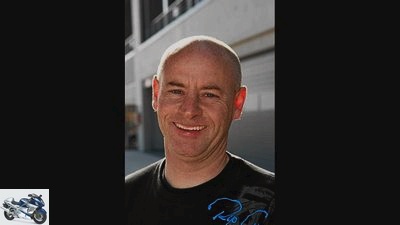
Arts
23/82
Tester: Karsten Schwers (MOTORRAD).
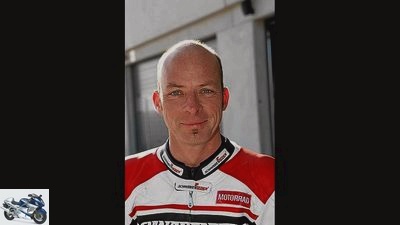
Arts
24/82
Tester: Andreas Bildl (MOTORCYCLE).
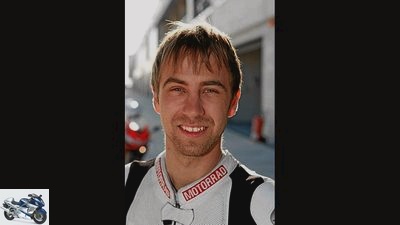
Arts
25/82
Tester: Freddy Papunen.
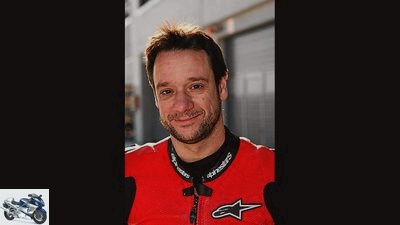
Arts
26/82
Tester: Oscar Marin-Pena.
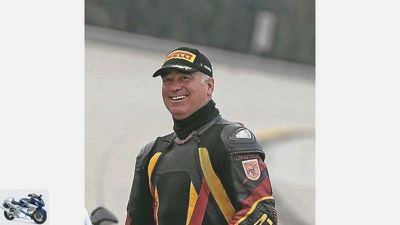
Arts
27/82
Interview: Salvatore Pennisi. Holder of 23 world speed records.
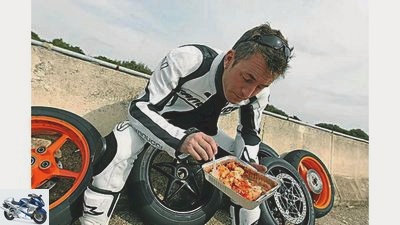
Arts
28/82
A break is a must!
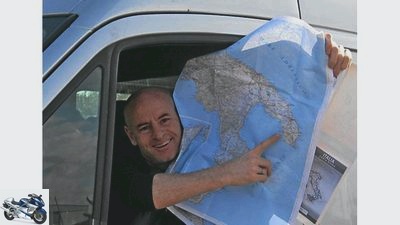
Arts
29/82
You shouldn’t lose your bearings.
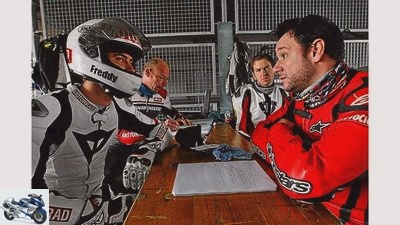
Arts
30/82
Discuss, note, ponder.
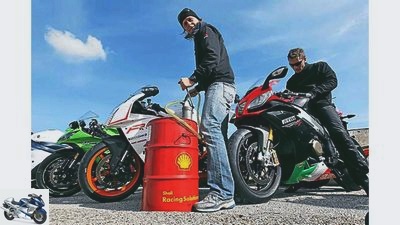
Arts
31/82
All measured values and refueling are meticulously documented.
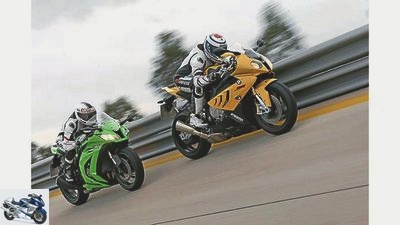
Arts
32/82
The tension at 300 km / h is great!
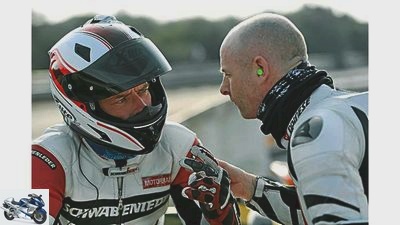
Arts
33/82
Take a break! But only briefly, because the time on the route is limited.
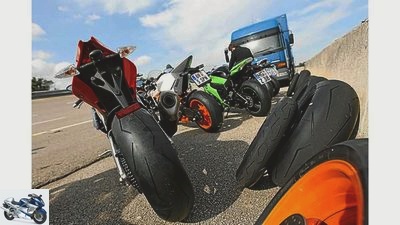
Arts
34/82
Look like production tires, but aren’t: special high-speed rubbers with a harder, more resistant rubber compound.
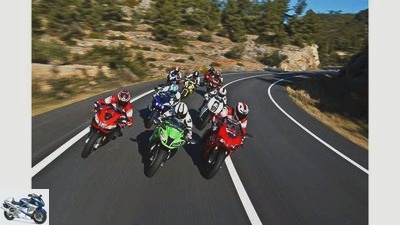
Arts
35/82
They cannot reach their full potential on the country road.
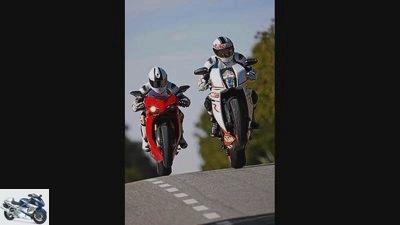
Arts
36/82
The V2 alternatives.
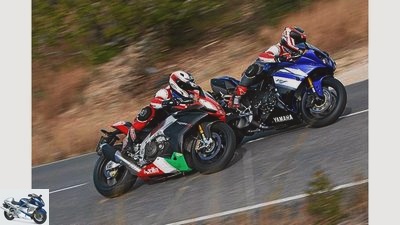
Arts
37/82
Alternative concepts.

Arts
38/82
Can the Kawasaki ZX-10R make the race?
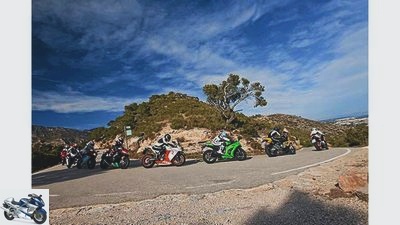
Arts
39/82
Who is the king on the highway?
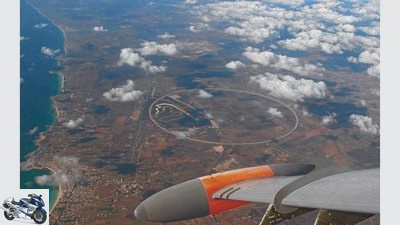
Arts
40/82
Looks like a huge roundabout.
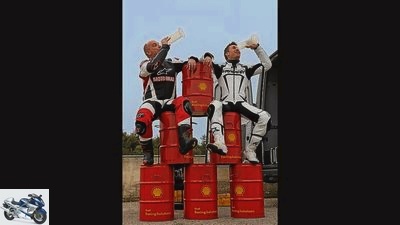
Arts
41/82
Not only the motorcycles are thirsty.
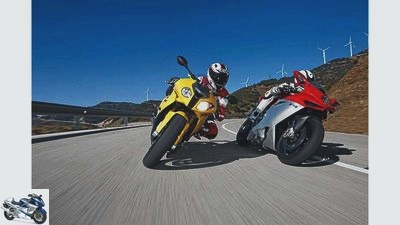
Arts
42/82
Europe’s row four.
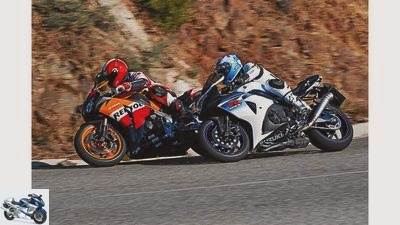
Arts
43/82
Japan’s traditionalists.
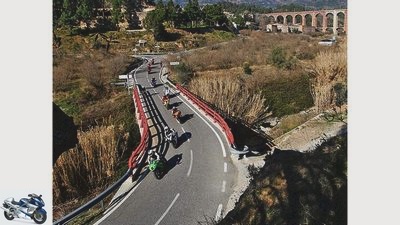
Arts
44/82
You can turn it however you want: Japan was caught off guard last year.
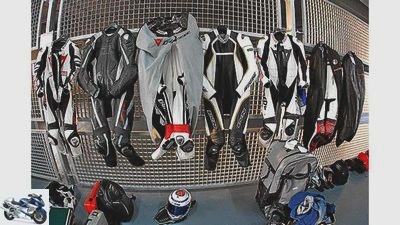
Arts
45/82
When testers drive off the (second) skin, sweaty leather is left behind.
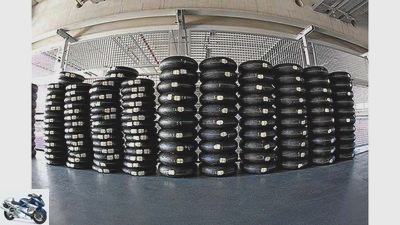
Arts
46/82
Tire to test.
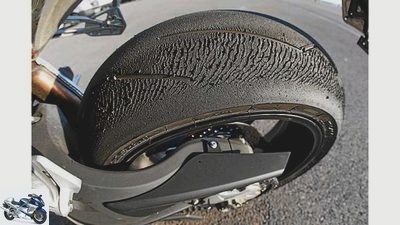
Arts
47/82
Drive until there’s nothing left of the rubber. The material was not spared.
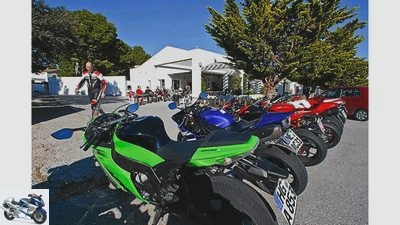
Arts
48/82
Lined up in order.
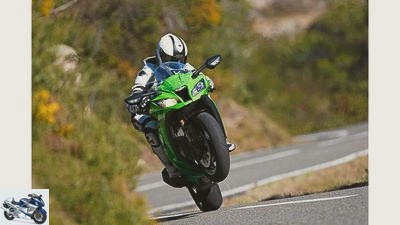
Arts
49/82
The challenger.
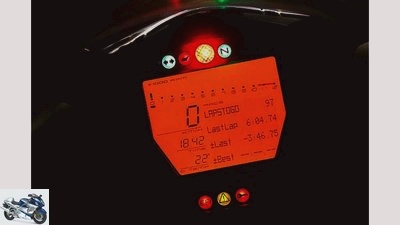
Arts
50/82
Cockpit: KTM.

Arts
51/82
Cockpit: Kawasaki.
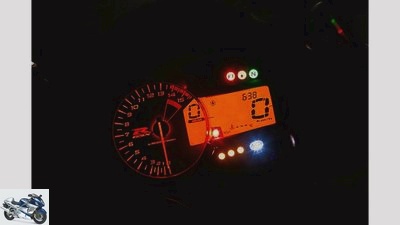
Arts
52/82
Cockpit: Suzuki.
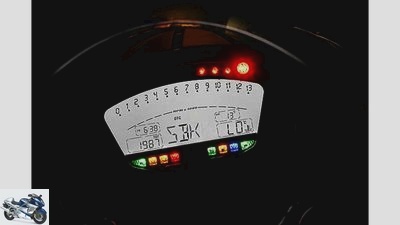
Arts
53/82
Cockpit: Ducati.
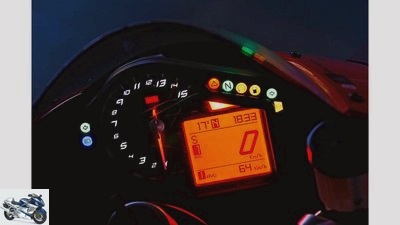
Arts
54/82
Cockpit: Aprilia.
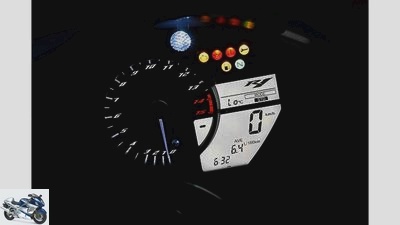
Arts
55/82
Cockpit: Yamaha.
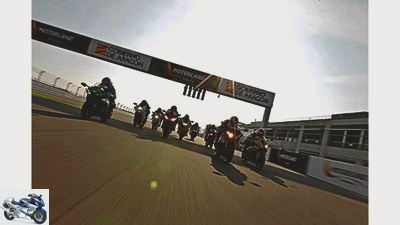
Arts
56/82
The pack chases the wolf.
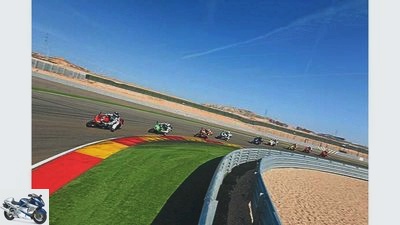
Arts
57/82
Up on the bike and pull on the cable until the winner is found.
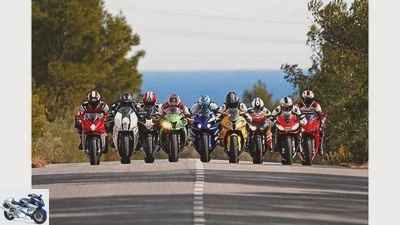
Arts
58/82
Who makes the race?
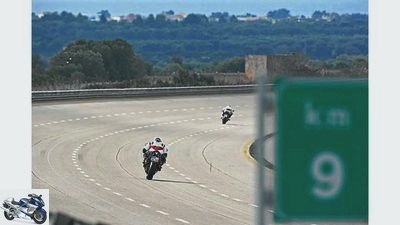
Arts
59/82
Due to their inclination, the upper tracks compensate for transverse forces up to about 240 km / h.
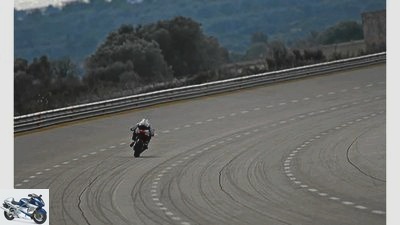
Arts
60/82
The high-speed line mercilessly reveals weaknesses.
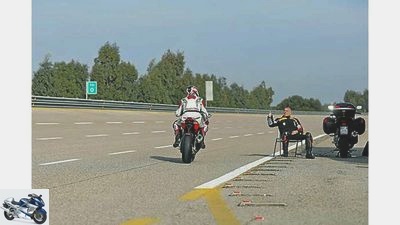
Arts
61/82
Relaxation and concentration before the sightseeing flight.
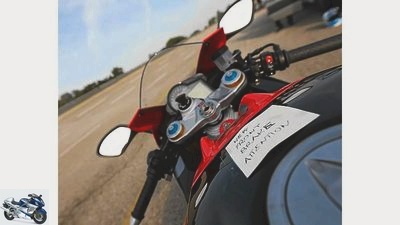
Arts
62/82
To be on the safe side, there is nothing like written reminders.
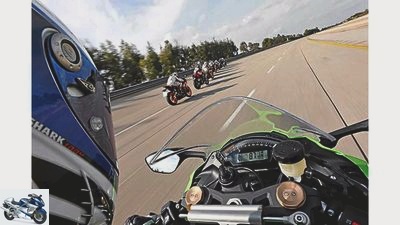
Arts
63/82
Speed regions beyond 250 km / h.
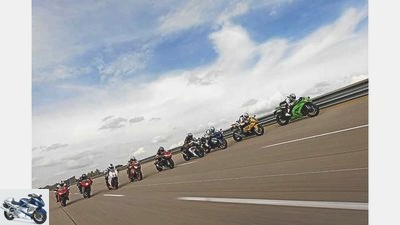
Arts
64/82
The excursion into the realm of extremes.
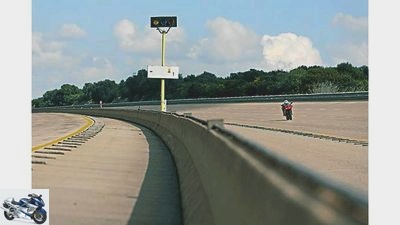
Arts
65/82
Keep your feet on the ground at this pace – and beyond.
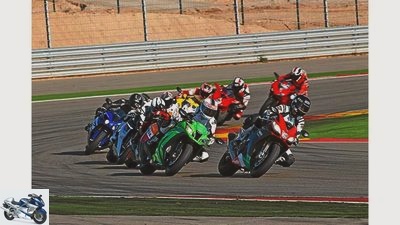
Arts
66/82
Aprilia and Kawasaki are not (yet) enough to jump to the top.
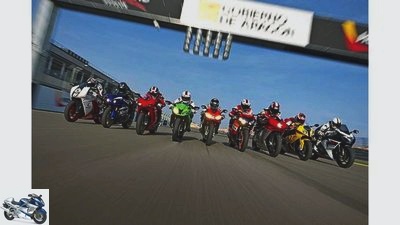
Arts
67/82
In Motorland Aragón, excellence alone does not win a flower pot.
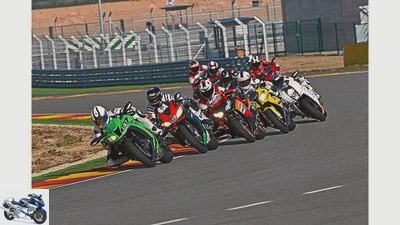
Arts
68/82
This is where the bikes feel most comfortable – on the racetrack.
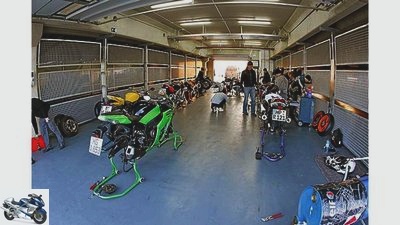
Arts
69/82
Tire change.
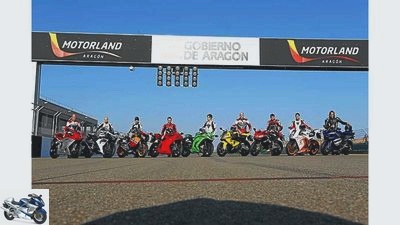
Arts
70/82
Motorcycles with riders – standing up for a change.
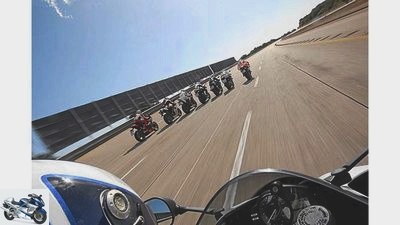
Arts
71/82
The high-speed circuit is about extremes.
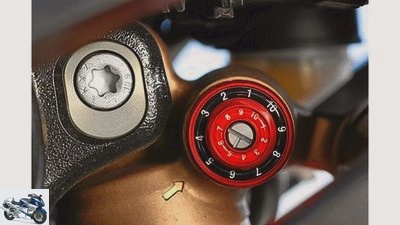
Arts
72/82
BMW S 1000 RR – equipped with spring elements that master the balancing act between acceptable comfort and sportiness.
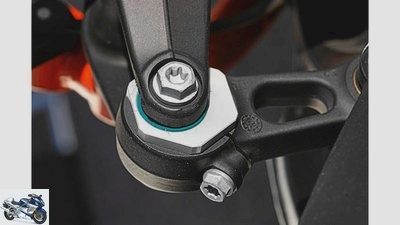
Arts
73/82
The KTM 1190 RC8 R has many intelligent solutions such as the rear height that can be quickly adjusted with the tool kit.
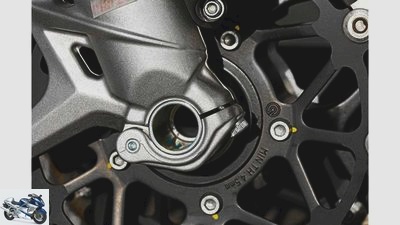
Arts
74/82
The MV Agusta F4 has quick-release fasteners for the front wheel.
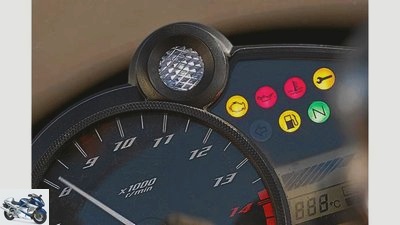
Arts
75/82
The Yamaha YZF-R1 has a bright, optimally placed shift light.
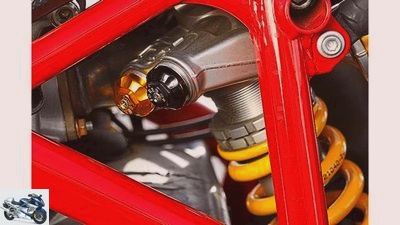
Arts
76/82
The TTX shock absorber from the Ducati 1198 SP from the 1198 R, fitted with a softer spring, helps the Duc to achieve a slightly better balance.
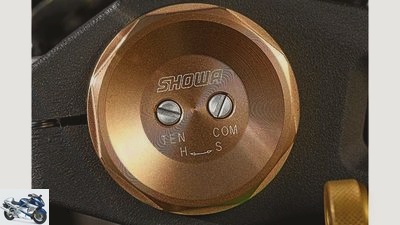
Arts
77/82
The impeccable big piston fork of the Kawasaki ZX-10R only lacks some feedback when it comes to the limit.
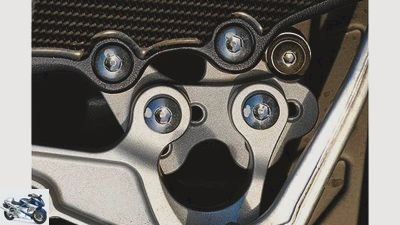
Arts
78/82
The notches on the GSX-R 1000 are adjustable in three positions.
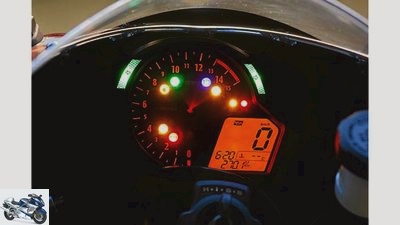
Arts
79/82
Cockpit: Honda.
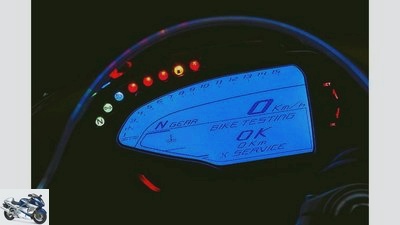
Arts
80/82
Cockpit: MV Agusta.
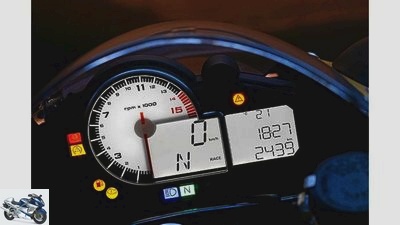
Arts
81/82
Cockpit: BMW.
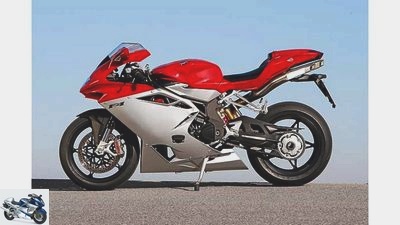
Arts
82/82
MV Agusta F4.
Megatest Supersportler 2011 (video from Nardo)
The super sports mega test part 3: high-speed
290 km / h is enough for a Boeing 737 to take off. For the nine superbikes, on the other hand, the motto is: stay on the ground at this speed – and beyond. Who is the high-flyer, who stumbles? And: This time all engines will stop?
Part 1: Country Road
D.he duty: everyday life, where performance is of secondary importance, all-round talent and good manners are important. A parquet on which the BMW moved most safely.
Buy complete article
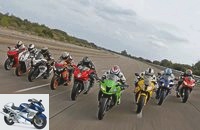
Megatest Supersportler 2011 (video from Nardo)
The super sports mega test part 3: high-speed
The freestyle: working on the lap times. Again the BMW prevailed, but only by a narrow margin. The Aprilia sits threateningly close to her neck.
this article
Part 3: high-speed track
The endurance test. The excursion into the realm of extremes. In speed regions beyond 250 km / h and at the limits of resilience.
Subscribe to MOTORRAD videos on Youtube
The helmet is pressed into the hollow on the tank, the wind rages and tugs furiously at every corner that peeks out from behind the fairing, while the engine screeches hysterically, the machine pushes mile by mile towards the magical 300 mark. In front of your nose, four lanes, swept empty: a seemingly endless, slight right-hand bend, but the end of which you never reach.
Welcome to the crazy world of Nardo. A 12.6 kilometer long asphalt circle with a four kilometer diameter and banked curves that allow a maximum of 492 km / h.
After a two-day, 1,600-kilometer journey, we have reached the high-speed Mecca with the nine superbikes that will carry out the last part of the test trilogy among themselves.
Salvo Pennisi, Pirelli test boss, former world championship superbiker and 23-time world speed record holder, welcomes us at the gate. He made this appointment possible for us on the heavily guarded prototype test site and now also ensures that the registration process is very relaxed.
However, there is no driving today. It is Saturday afternoon. The machines have to be prepared for tomorrow. Check the oil, lubricate the chain, install the recording. And for the final high-speed test, special high-speed tires have to be fitted to the replacement rims brought along.
Today it would be too windy to drive anyway. Tomorrow, says the weather service, tomorrow should be good. Sunday morning. At a quarter past six everyone is already having breakfast in the hotel. The tension is huge. The weather is actually at its best and the track is clear from eight o’clock. Completely free. During the week the pace increased "just" 240 km / h is limited, Sunday has no limits.
First of all, head tester Karsten will accelerate the nine superbikes from a standing start to 250 km / h, whatever is possible. And of course see how fast the machines really are, with big ears and a kilometer-long run-up. Full throttle for a moment, you might know that from the autobahn, but letting it stand for a full one, two or three kilometers is something else.
Then the iron is fully reached from a speed of 250. Accelerating like braking is a ticklish affair. The former, because the slightest twitch or a wheelie that is a little too strong can ruin the measurement. And if possible, the coupling should not be slaughtered during the measurements.
The subsequent emergency braking from 250 km / h is also a dance on the knife edge. Over a braking distance of around 250 meters, the brake must deliver a clear, constant pressure point so that the balancing act at the blocking limit does not end in scrap.
Arts
In Motorland Aragón, excellence alone does not win a flower pot.
Somewhat abstract values, perhaps, such as consumption at 250 km / h or pulling through from 150 to 250 km / h. But this reveals a lot about the performance and efficiency of the machines and their brakes. And the latter in particular can be quite important in everyday life. Karsten has meanwhile attached the GPS antenna of the Recording to his helmet, it no longer holds him. All machines have warmed up carefully, Karsten grabs the Aprilia and roars away.
A few minutes later he comes back from the first measurement round. As always, when a driver gets off the petite RSV4, he grins too. Reported about the great stability, complained about a somewhat crumple clutch, but raved about the automatic gearshift and the crisp, short, precise gear changes, which ultimately favor the fantastic 11.2 seconds that the RSV4 APRC SE needs at 250 km / h. But above all, it swings up to an almost unbelievable 297 km / h top speed, spurred on by excellent aerodynamics.
And when braking? If the Aprilia pays tribute to its uncompromising design, compact design and high center of gravity, it takes off with the rear wheel. But thanks to the amazingly gripping and super adjustable stoppers, the dance on the front wheel can be easily controlled. So the RSV4 is after 241 meters, which will still be the third best value in the end. Anyone who lifts their finger now that there should actually be even better values should know: With a µ value of 0.79, the Nardo asphalt is not particularly handy. Conventional roads usually have µ values around 0.9.
And then Karsten is already on the 12.6 kilometer lap with the BMW. A 200 hp grenade, full of electronics, the Aprilia values are sure to fall, right? They fall. But not without further ado. It only takes 10.1 seconds for the BMW to crack the 250 mark, but that only works when the traction control is switched off. To do this, the wrist has to regulate the wheelies that the BMW still does even in third gear. Otherwise, however, the way the engine picks up and, thanks to the automatic gearshift, slips in one gear after the other is splendid. The 200 km / h mark falls after 206 meters and the 300 mark is stormed after 1112 meters. For a short time the rear tire heats up to 130 degrees during this acceleration orgy. The forward thrust of the BMW only fades at 305 km / h. There is a bit more movement through the chassis than with the Aprilia. But when braking, the BMW is a force and comes to a halt twelve meters in front of the RSV4. Your brake discs heat up briefly to 290 degrees, those of the Aprilia even to 330. The others also moved within this range.
It was to be expected that the BMW would initially win the Blue Ribbon with its enormous extra performance. But will it pull the Kawasaki off her right away? Karsten folds down the visor and sweeps off with the green one. Are the BMW records now falling in terms of acceleration and top speed? No, they don’t fall. "It is not easy to accelerate the ZX-10R perfectly. The weak middle costs tenths of a standing start, at the top the green continues to fire so aggressively that the front wheel can hardly be kept on the ground", reports Karsten after his return. Nevertheless, up to 150 km / h it is on par with the top values of the BMW. But above that the white-blue pulls away.
While second gear on the Kawasaki is geared up to almost 200 km / h, which requires a shift in the somewhat bony gearbox shortly before the measuring point, the gearbox connections on the BMW fit better and the automatic gearshift saves time when changing gears.
Incidentally, Kawa and BMW are the only ones in which fourth gears reach over 250 km / h and thus save a shift when accelerating to 250 km / h.
At top speed, however, the green from BMW and Aprilia gets hit on the hat. 294 km / h is anything but a slow pace. But in view of the performance, no act of glory either. Alone, the ZX-10R can’t go any faster, because it runs into the limiter at this speed. Obviously, the developers tried to spice up the moderate pulling power with a short overall translation. Nevertheless, Aprilia, BMW and Kawasaki are in a class of their own, the rest are scrambling for places.
Arts
The high-speed circuit is about extremes.
The Honda scores with sovereign straight-line stability and powerful pulling power. Top speed and braking distance are only in the back third. The Suzuki can be easily accelerated thanks to the precise clutch and precise transmission. When braking, it looks cloudy. The blunt brake, which can only be metered with little effort under such enormous loads, only brings the Suzuki to a stop after 259 meters, 30 later than the BMW. Taillight. Or to put it another way: where the BMW is already standing, the Suzuki rushes by at 85 km / h. The Yamaha, which is very stable, comes to a standstill eight meters earlier than the Suzuki. But the moving pressure point hardening during this violent maneuver impairs the controllability. And the weak R1 showed the strongest thirst. The Twins, on the other hand, proved to be extremely economical with the Tempo bolt. But they cannot set any further highlights. The briefly translated KTM requires a lot of concentration and a nimble shifting foot so that the acceleration is optimal up to 250 km / h. And shortly afterwards the twin, which vibrates sharply at high speeds, runs into the gruff limiter at 282 km / h. Despite the new linings, the Ducati clutch was not entirely free from the typical chattering of dry clutches. So of course there isn’t too much to inherit in the sprint. When braking, it brings the coals that have just been lost out of the fire with full stability. But the twins, especially the Ducati, stumble at full throttle. If the KTM cannot resist a certain restlessness in the highest speed regions, the Ducati wants to be touched with ice cream gloves so that the latent slight stirring does not take on unpleasant forms, for example when driving over longitudinal grooves. Really stable is different.
Speaking of stable, isn’t there one missing? Exactly, the MV Agusta. Your clutch, which is inconspicuous in everyday life, requires a lot of tact for the acceleration sprint, but then! It thunders steadfastly like a freight train through the round. Her four-cylinder trumpets fervently from the four organ pipes under the seat, turning and turning until the MV, thanks to its sensational aerodynamics, is the only one next to the BMW to break the 300 km / h sound barrier.
The recording reports 301 km / h later. And the MV moves up to third place next to the Aprilia. Chapeau!
So, the scoring is tucked away under the roof, stopwatches and data recording. Final sprint, the endurance test, the endurance test. Nine laps of full throttle. The Pirelli mechanics are already assembling the wheels with the high-speed tires. They would have had far too little grip for the acceleration and braking measurements. That was a matter of production tires. But full throttle would destroy them within one or two laps at the latest. And all tanks are flooded again with 100-octane Shell V-Power Racing.
As a reminder: KTM, Aprilia, Suzuki and Yamaha breathed their lives on the track last year (Motorrad 8/2010). While the RSV4 did not even survive the warm-up lap, the cause of the KTM was clearly the wrong fuel. The high-compression RC8 R calls for Super Plus and, due to an accident, was only poured ordinary Super. But even with the others, it could not be completely ruled out that the fuel that was filled up in Nardo was completely uninvolved. A random test showed that the quality was still within the framework, but at the lower limit of the tolerances. So this time the motto was: No compromises. Which is why Shell made 400 liters of the finest V-Power Racing available.
Arts
Keeping your feet on the ground at this speed – and beyond.
Salvo gives the final instructions for breaking in the special tires: one lap at 150 to 180 km / h, then off we go. Full throttle, everything that works, for a whole lap. Almost three minutes of continuous full throttle. Then stop, do a quick check, change driver and then again. Nine rounds.
110 kilometers. A murderous stress, also for the neck muscles. The only relief for the delinquents: Whoever is standing in the limiter, briefly closes the gas and then accelerates again.
And then the nine machines are on the move in a circle. Paint one endlessly long black line after another on the roadway. A good 290 km / h still require a good 25 degree incline on this circular path. And they put enormous lateral forces on the rear tire, plus a pressure of a good 240 kilograms on the rear tire.
What an ordeal. But all of them survive this acid test. Tires, machines, drivers. After this test, there is probably nothing to shake in the stability of the nine superbikes. But neither did the BMW win.
The trilogy at a glance
Arts
Here on the country road – but also on the racetrack and the high-speed track was tested.
The battle is over, the points are counted. It got tight.
The BMW was able to hold its own at the top once again. But her throne is shaking. The surprisingly strong new Kawasaki has catapulted itself from fourth place last year, which the previous model took, just behind the BMW in the overall standings. In their slipstream: the revised Aprilia.
On the country road, the Kawasaki only missed victory by a hair’s breadth despite its lack of torque. And on the racetrack, the Aprilia was really only missing an ABS and the corresponding points for the partial victory. This trio also leads the Superbike crowd in the end. Last year’s podium candidates, Honda and Yamaha, on the other hand, have slipped backwards.
Standing still in this league inevitably means going backwards. Whereby the pale representation of the R1, with which it has to line up behind the certainly no longer brand new Suzuki, was surprising. But the performance of Kawasaki and Aprilia shows that the BMW is not untouchable. And that should actually be an incentive for the other manufacturers to step up. But it still simply offers the best overall package. One or the other may be handier, more comfortable or even stronger in the draft. But in the sum of its characteristics, the BMW is again the alpha animal in 2011.
In the end, there was nothing to inherit for the two-cylinder. Although the KTM has gained tremendously thanks to the revision, especially on the country road. There it also shows that high torque takes precedence over pure top performance. In principle, this also applies to the Ducati. But the Italian is simply exhausting in public, and in Nardo there was ultimately a clear gap to the top. With all the fascination. But she has retained that in the current year.
archive
What comes out at the back – performance diagram.
Usually we map the performance curves in relation to the speed. In this case, however, it is worth considering the rear wheel performance curves in last gear. Then it becomes clear, for example, why the Ducati gives up in the pull-through test. It is true that their strong increase in performance in the medium speed range suggests unbelievable explosiveness during normal driving. But that doesn’t count here in Nardo. The only thing that counts here is the performance that is still needed on the rear wheel. And at 150 km / h that’s almost 20 hp less than the competition.
In contrast, a machine comes to the fore that otherwise plays a really good, but inconspicuous role: the Honda Fireblade. Despite its relatively modest top performance, it swings the greatest hammer of all between 140 and 200 km / h – even before the BMW. Keyword round table discussion. Because it shows that top performance alone is nothing, especially not in everyday life. Tangible pulling qualities are much more important.
The Kawasaki must also recognize that. Only from 240 km / h does it manage to outperform the Honda. Between 150 and 220 km / h the speed-hungry ZX-10R four-cylinder is even behind the significantly weaker Yamaha.
Against this background, the performance of the BMW engine is all the more astonishing. Up to 200 km / h good with music, the performance curve then takes off to an impressive height, as if the BMW was playing in a different displacement league. The logical consequence is superior driving performance. One must acknowledge this without envy.
Readings
| Aprilia | BMW | Ducati | Performance | Top speed * km / h | 297 (290) | 305 (299) | 288 (288) |
| Acceleration. 0-100 km / h sec | 3.2 | 3.1 | 3.1 | 0–200 km / h sec | 7.3 | 6.9 | 7.9 |
| 0–250 km / h sec | 11.2 | 10.1 | 12.7 | Draft 150–250 km / h sec | 9.2 | 8.3 | 11.6 |
| L.performance on the rear wheel PS | 166.9 | 189 | 158.4 | Braking distance 250–0 km / h m | 241 | 229 | 245 |
| delay m / s2 | 10 | 10.5 | 9.8 | consumption |
| Ø 250 km / h liter | 14.2 | 14.2 | 12.8 | Range Ø 250 km / h km | 120 | 127 | 141 |
| Fuel type ** | S. | SP / S | S. |
| Honda | Kawasaki | KTM |
Performance
| MV Agusta | Suzuki | Yamaha | Performance | Top speed * km / h | 301 (305) | 292 (295) | 287 (285) | Acceleration. 0-100 km / h sec | 3.4 | 3.1 | 3.1 |
| 0–200 km / h sec | 7.7 | 7.4 | 7.5 | 0–250 km / h sec | 11.6 | 12th | 12.7 |
| Draft 50–250 km / h sec | 10.7 | 9.7 | 10.1 | Performance on the rear wheel PS | 167.6 | 158.5 | 157 |
| Braking distance 250–0 km / h m | 249 | 259 | 251 | delay m / s2 | 9.7 | 9.3 | 9.6 | consumption | Ø 250 km / h liter | 13.9 | 13.4 | 15.3 |
| Range Ø 250 km / h km | 122 | 131 | 118 | Fuel type ** | S. | S. | S. |
* Values in brackets: manufacturer information, ** S = Super, SP = Super Plus
Conclusion
Arts
BMW S 1000RR: The queen of speed.
1st place: BMW S 1000 RR
The queen of speed fighters. Top performance, impressive pulling power, decent stability, everything is there. And when things get tough: fantastic brakes.
2nd place: Kawasaki ZX-10 R
Huge sprinting ability and bombastic brakes are on the plus side. However, the short gear ratio costs top speed and still does not bring outstanding torque values.
3rd place: Aprilia RSV4 APRC SE
The agile, lively Aprilia is also a force on the high-speed slopes. Even more stable than the BMW, with enormous braking power and considerable pulling qualities.
3rd place: MV Agusta F4
More than a respectable success. As on the racetrack, the MV shows: Speed is her thing, not a stroll. Thanks to top aerodynamics, incredibly fast and stable.
5th place: Honda Fireblade
Even under these extreme conditions, the Honda pulls out of the affair respectfully. Together with the MV, it even sets the record for stability.
6th place: Suzuki GSX-R 1000
It is not enough to be more than mediocre despite a good draft. At top speed, acceleration and, above all, the brakes, the gap to the front is too big.
7th place: Yamaha YZF-R1
The Yamaha doesn’t do really badly. But in this circle the weak and thirsty engine is a mortgage.
8th place: KTM 1190 RC8 R
Unfortunately there are no points for handiness in the roundabout. Mistakes in the straight line and only average mileage result in the ungrateful eighth place.
9th place: Ducati 1198 SP
In the third part, too, the pretty Italian only has the bottom rank. The good braking performance cannot compensate for the nervous straight-line stability and the moderate pulling power.
MOTORCYCLE speed rating
A world of its own: the BMW engine and brakes. The top speed of the ZX-10R is almost a bit disappointing. Likewise the braking performance of the Suzuki. The Honda shines with great pulling power and enormous stability, as does the MV, which is also extremely fast.
Winner speed classification: BMW S 1000 RR
| Max points | Aprilia | BMW | Ducati | Honda | Kawasaki | Total | 400 | 172 | 185 | 154 | 167 | 173 |
| placement | 3. | 1. | 9. | 5. | 2. |
| Max points |
KTM |
MV Agusta |
Suzuki |
Yamaha | Total |
400 | 155 | 172 | 165 | 156 |
| placement |
8th. | 3. | 6th. | 7th. |
MOTORCYCLE overall rating
Arts
So far, the BMW is unbeatable in all disciplines.
| Max points | Aprilia | BMW | Ducati | Honda | Kawasaki | Total | 1600 | 1205 | 1260 | 1098 | 1196 | 1225 |
| placement | 3. | 1. | 9. | 4th. | 2. |
| Max points |
KTM |
MV Agusta |
Suzuki |
Yamaha | Total |
400 | 1146 | 1140 | 1152 | 1148 |
| placement |
7th. | 8th. | 5. | 6th. |
MOTORRAD overall result
1st place: BMW S 1000 RR
Everyday life: 1st place
Racetrack: 1st place
High-speed track: 1st place
She is nowhere naked and dominates the athlete squad again.
2nd place: Kawasaki Ninja ZX-10R
Everyday life: 2nd place
Racetrack: 3rd place
High-speed track: 2nd place
A more than successful debut. A second place in this strong test field can almost pass as a small victory.
3rd place: Aprilia RSV4 Factory
Everyday life: 4th place
Racetrack: 2nd place
High-speed track: 3rd place
Maybe the newcomer of the year. The placement not only reflects their talents, but also the fun they make.
4th place: Honda Fireblade
Everyday life: 3rd place
Race track: 4th place
High-speed track: 5th place
Even if it did not make it to the podium this time: Your balance, free of serious weaknesses, is your great asset.
5th place: GSX-R 1000
Everyday life: 6th place
Race track: 8th place
High-speed track: 6th place
Once again, her four-cylinder in particular secures her a solid place in the midfield. But the gap ahead is big.
6th place: YZF-R1
Everyday life: 5th place
Race track: 6th place
High-speed track: 7th place
It sets accents in everyday life thanks to handling and a fun engine, but ultimately a good shot of power and crispness is missing.
7th place: KTM 1190 RC8 R
Everyday life: 6th place
Race track: 6th place
High-speed track: 8th place
A charming, handy, but also idiosyncratic thunder bolt, which has gained further compared to 2010.
8th place: MV Agusta F4
Everyday life: 8th place
Racetrack: 4th place
High-speed track: 3rd place
It’s a shame, the points mortgage from the Landstrasse section is too heavy. Because the performance on the racetrack and in Nardo was good.
9th place: Ducati 1198 SP
Everyday life: 8th place
Race track: 4th place
High-speed track: 3rd place
It demands taker qualities from its pilot, demands dedication. But then she rewards them with great emotions.
jahn
Salvo Pennisi, 54, has been Head of Tests at Metzeler / Pirelli since 1986.
Whether off-road works for Ducati in the seventies or on Rumi-Honda in the nineties in the Superbike World Championship. Salvatore Pennisi, Pirelli motorcycle boss and also holder of 23 world speed records, lives and breathes motorcycle.
For what reason do special tires have to be fitted for high-speed journeys??
In this test in Nardo, with its special conditions, the extremely high speeds, the longitudinal and lateral forces, especially in the excessive corners, the so-called “banking”, the tires are subjected to enormous stress. Not only because of the high speeds and the added forces from the contact pressure. In addition, there are enormous lateral forces due to the inclined position. These are loads that can never be reached on the road. From an internal temperature of around 130 degrees it becomes critical for a series tire, then chunking begins. A standard tire would survive here one, at most two laps.
How do these tires differ from standard tires??
In terms of carcass, they are actually identical to our conventional road tires, i.e. based on a 0-degree steel belt construction, which guarantees high stability and minimal centrifugal growth of the tire at high speed. Therefore we do not need a special construction, just a special rubber compound.
Under these conditions, a two-cylinder puts more stress on the tires than a smooth-running inline four-cylinder?
Normally, two and four cylinders already put stress on the tires in different ways. But here the occurring longitudinal and transverse forces are the decisive factors, regardless of the engine type.
Shell
Richard Karlstetter (49), Head of Fuel Technology Motorsport Shell.
Even if all types of gasoline have to comply with certain standards, gasoline is not just gasoline, which additives make. And if there are high loads, the use of high-quality fuel is not a waste of money.
Are there qualitative differences in gasoline between Northern, Southern or Eastern Europe??
All fuels in Europe must comply with the EN 228 fuel standard, which defines the physical and technical properties. But these are only minimum requirements. Fuels vary in the composition of the base fuel and the additives depending on the manufacturer. Shell fuels exceed these requirements and are the same all over Europe.
If you are faced with high loads such as visiting a racetrack, you should refuel with higher quality fuel even with an engine designed for 95 octane (RON)?
A higher knock resistance gives more reserves, which are particularly important when operating in the limit range, such as high speeds or temperatures, and can protect against possible knock damage. The octane number prescribed by the manufacturers relates to new, clean engines and normal operation, i.e. not to high continuous speeds. And clean engines are less prone to knocking than engines with deposits in the combustion chamber. The additives in V-Power provide an additional cleaning effect, so they can break down deposits from valves and combustion chambers with permanent use. Which reduces the risk of knocking and pressure peaks.
Are fuel additives an alternative?
In no case should you try to improve a fuel by means of additives that you add to the fuel yourself. In the best case, nothing happens and the quality is retained. In the worst case, the fuel properties are out of balance, which can lead to engine damage.
Related articles
-
Comparison test of the 1000 super sports car
Jaime de Diego 38 pictures fact 1/38 Yamaha demands 14895 euros for their completely new R1 super sports car. fact 2/38 Even without ABS, the Fireblade would …
-
Comparison test of the 600 super sports car
Ducati 748 R. Comparison test, Ducati 748, Honda CBR 600 F, Kawasaki Ninja ZX-6R, Suzuki GSX-R 600 600 super sports car in the test Fireworks! Kawasaki’s…
-
Comparison test of the 1000 super sports car, part 2
Jahn Comparison test of the 1000 super sports car, part 2 The street sweepers Fun surfing on country roads, everyday operations, sober cost-benefit…
-
Comparative test of the super sporty 600 series, part 2
Gargolov comparison test super sporty 600, part 2 roundabout last groove and full of gas ?? when comparing the racetrack there is for the …
-
Test of the 600 super sports car
Jaime de Diego Test of the 600 super sports car Speed monster in the track test The first part of the comparison test takes the current super athletes…
-
2017 super sports car in the country road comparison test
fact 28 photos factstudio.de 1/28 The 2017 superbikes were just battling it out on the racetrack, now the focus is on the country road, everyday…
-
Comparison test of the 1000 super sports car, part 1
Jahn Comparison test of the 1000 super sports car, part 1 The full program Lean, strong, ready for attack, the Suzuki GSX-R 1000 completes the field of…
-
Comparison test of the 600 super sports car
Comparison test of the 600 super sports car It’s getting tight Riot in the sports group. A whopping 124 hp, a ridiculous 207 kilograms with a full tank,…
-
600 super sports car in the test
38 photos 1/38 Here again, all in one go: The 600 super athletes on the racetrack. 2/38 70 hp less than the 1000,…
-
The super sports mega test part 1: Country road
Kuenstle 82 pictures Kuenstle 1/82 Easy to use traction control of the Aprilia. Kuenstle 2/82 A thoroughbred racing file with incredible handling ….